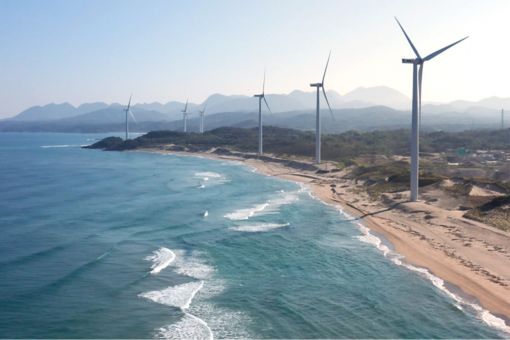“Fast-tracking the energy transition” is one of the key aims of the COP28 UN Climate Change conference that the United Arab Emirates will host in Dubai from 30 November.1 Energy is responsible for around three-quarters of greenhouse gas emissions and the industry is already changing rapidly, but it needs to do so faster to lessen the impacts of climate change.
The International Energy Agency predicts that the growth of clean energy means that demand for coal, oil and natural gas will all peak this decade and that electric cars will account for two-thirds of all new car sales by 2030. But while the agency estimates US$1.8 trillion will be invested in clean energy this year, a new record, it says this needs to reach around US$4.5 trillion a year by the early 2030s if the world is to reach net-zero emissions by 2050.2
Energy extraction, generation, transmission and distribution involves risks, particularly when adopting new technologies. While the energy transition presents the insurance industry with a series of net zero reporting and industry challenges, KPMG professionals believe it also creates opportunities for insurers to support the energy sector on the journey to a cleaner future.
What insurers can do for clean energy
Insurers and reinsurers already provide cover for renewable energy, although they could do more. They will need to be able to adapt some existing policies and products covering traditional fuels to make them work for clean energy, with training for underwriters to assist them in supporting this adaptation of existing products.
Insurers will need to consider the creation of new products suitable for producers of new fuels including biodiesel and green hydrogen and new activities like carbon capture. Organizations can speed up this process by establishing innovation labs, as some have already done, and look for adjacencies in other industries to provide underwriters with initial frameworks.
KPMG’s ESG professionals believe that digitalization and decentralization will be key themes of the energy transition. It is always harder to price risks for a new activity that lacks a detailed track record, but insurers can use digital technology including artificial intelligence (AI) to make the best use of the data that is available and to bring it into use rapidly.
The shift to new energy technologies could see a decentralization with some organizations having to insure against energy-related risks for the first time. New fuels created with clean electricity could be produced close to where they are needed meaning that airports, for example, could produce sustainable aviation fuels on-site rather than bringing these from refineries.
While these types of changes will present opportunities for insurers there are challenges as well, including changing risk profiles. For example, there is a massive need for individuals and businesses to substantially increase the generation of clean energy with solar panels and use batteries to store it on-site, or change to different types of energy like hydrogen.
Property insurance will need to adapt to these changing risk profiles, which can have implications for not only pricing, but capital requirements as well. Insurers will need to work alongside companies assisting on the energy transition to ensure their products remain relevant. This will likely be critical to help ensure they remain a going concern and therefore important to be included within their transition plans and be a leader in this respect, to take competitive advantage of the transition.
Supporting the fast-track energy transition
Insurers and brokers can help accelerate energy’s pace of change by providing advice on the transition and how to mitigate the associated risks when organizations introduce new operations or change existing structures. Doing so also requires a willingness by those involved in the energy transition to involve insurers and brokers earlier on in the development of energy transition projects and programs, including alongside financial institutions funding the work.
Insurers could also develop products that directly incentivize the energy transition, but this needs to be done with care so as to move with society rather than getting ahead of it. It may be better to adopt a steady pace of change that stays within the mainstream, which can help to de-risk the impacts of inevitable short-term political changes.
The increasing pace of investment in clean energy and calls to move faster mean that insurers and reinsurers need to plan for an accelerating energy transition. This means identifying the changes they will need to make to products and coverages in both retail and commercial sectors. This could include the development of new underwriting tools that generate insights relating to the energy transition when calculating premiums; investing in innovation that can allow insurers to make significant changes rather than incremental ones; and learning from balance sheet investments to get clearer views on how sectors and insurable assets are being affected. It makes sense to incorporate the opportunities as well as the risks of the energy transition into business planning then work with providers of capital and the rest of the insurance industry to enact these plans.
The fast-track transition needs insuring
As COP28 will remind us there is an urgent need to fast-track the energy transition, something which will be impossible without the support of insurers and reinsurers. Industry leaders already recognize that they have a role to play and that it presents huge opportunities. There has been a tendency to focus on the activities and sectors that insurers should not cover or should phase out, but a focus on opportunities would provide a better way to support changes in how we produce and consume energy.
Insurers provide a social good by helping people and organizations to manage risks and cope with crises. Public perceptions of the industry are often shaped by things going wrong and rising premiums, such as for electric vehicles (see box). There is a danger that the insurance industry could be seen as holding back the energy transition, but we believe this can be countered through positive action such as by upgrading product ranges to support clean energy, working to improve the pricing of risks and providing early-stage advice in the development of energy transition projects.
KPMG climate and decarbonization professionals are assisting insurers and reinsurers plan for the energy transition through its climate and decarbonization experts in both insurance and the energy sector in member firms around the world.
Rising electric vehicle premiums show value of learning from early transition activities and preparing now
The take-up of electric vehicles (EVs) has been constrained by worries over battery ranges and availability of suitable chargers. These concerns may fade as battery technology improves and charger numbers increase, but have now been joined by the increasing cost of insurance.
To encourage adoption, many governments have subsidized the costs of buying and taxing EVs, but not maintenance, repair bills and in large part the infrastructure changes required. Maintenance and repairs tend to be higher for EVs than for gasoline and diesel vehicles given pricier components, the cost and difficulty of servicing EV batteries and shortages of qualified mechanics. Some of these challenges are likely to ease as businesses adjust to the sharp growth in EVs, but for now insurers are reflecting increased costs in their premiums. And when consumers are navigating high interest rates, inflation and the cost of living, another increase is likely to be unwelcome.
The danger is that the insurance industry gets portrayed as profiteering from the move to EVs, with similar situations likely in future as rapid green technology adoption causes supply chain issues particularly given the rising geopolitical risk. It’s important that insurers become able to not only consider the immediate risks from a pricing perspective, but learn from early transition activities and help industries assisting with the transition mitigate similar scenarios in the future. If the insurance industry does this, then we should expect it to be seen as aiding rather than abetting the acceleration of the energy transition by our customers and capital providers.
Contact our Insurance and Sustainability experts
Connect with us
- Find office locations kpmg.findOfficeLocations
- kpmg.emailUs
- Social media @ KPMG kpmg.socialMedia
Explore
1 Sultan Al Jaber, 'Letter to parties', COP28UAE, 13 July 2023. https://www.cop28.com/en/letter-to-parties
2 Executive summary, 'Net Zero Roadmap: A Global Pathway to Keep the 1.5°C Goal in Reach', International Energy Agency, September 2023. https://www.iea.org/reports/net-zero-roadmap-a-global-pathway-to-keep-the-15-0c-goal-in-reach/executive-summary




